This article was originally written in June, 2010.
When the University of Wisconsin’s Blake Geoffrion won the 2010 Hobey Baker Memorial Award for college hockey’s best player, he was the new Crown Prince of NCAA Hockey. Like a champion thoroughbred racehorse, Blake’s hockey blood lines can be traced back four generations. Howie Morenz, his great-grandfather, who played fourteen years in the NHL (twelve of those years with the Montreal Canadiens), is considered by some to be the best of all time. His grandfather, Bernie “Boom-Boom” Geoffrion, married Howie’s daughter Marlene and after an outstanding career in Montreal, New York and Atlanta as player, coach and TV personality, followed his father-in-law into the Hockey Hall of Fame. Dan, his father, played four years in the NHL. Now, it is Blake’s turn.
Let’s take a look back in time at the evolution of this family dynasty.
The Origins of Howie Morenz
It all began at the turn of the 20th century with a talented young forward from Stratford, Ontario. Born in Mitchell, Ontario on June 21,1902, he started his career playing pond hockey on the Thames river. When the family moved to Stratford in 1917 Howie played five seasons with the Stratford Midgets of the OHL, leading them to the 1921 Memorial Cup finals against the Winnipeg Falcons. Despite his spectacular personal performance, they lost eleven-nine in a two-game total point series.
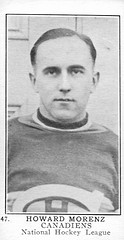
After the series, Falcon defenseman, Harry Roth said: “It was Morenz, Morenz, Morenz, as the fastest junior I ever saw, scored goal after goal. Howie had speed to burn. He would come right up to you and when you tried to check him he wasn’t there.” He was soon dubbed: “The Stratford Streak”.
In 1920 he became an apprentice in the Canadian National Railway shop in his hometown. His hockey ability had a great deal to do with his appointment. Playing in a CNR Tournament game between teams from Point-St-Charles and Stratford at the Mount Royal Arena in December of 1922, Morenz scored nine goals. Ernest Sauve, after refereeing the game, drove immediately from the arena to the Windsor Hotel office of Leo Dandurand, managing partner of the Montreal Canadiens. There he informed his friend of this newfound marvel on skates.
Morenz the Canadien
Dandurand, who, along with his two friends, Joseph Cattarinich and Louis Letourneau, had acquired the team for eleven thousand dollars the year before, made a trip to Stratford in January to see him play and marveled at his innate abilities on the ice. His speed, his passion for the game, his checking prowess, all added up to a brilliant future wherever he decided to play. In a meeting at the Morenz home with Howie and his father William, Dandurand was informed that the boy would not be allowed to make any move away from Stratford that would interfere with his apprenticeship at the CN factory that had two years to go before completion. “It would be regrettable if he abandoned his trade,” mused William.
In July, after hearing that Morenz father and son had been considering playing for the Toronto St. Pat’s, Dandurand summoned Cecil Hart, his trusted negotiator, to his office, armed him with signed checks for different denominations and put him on a train for Stratford. “Do not return without a signed contract,” he told Hart. By the end of the next day Hart visited Stratford, had worked his magic and was able to inform his Montreal patron that the deed was done. By coincidence the signing was concluded on July 7, 1923, Dandurand’s 34th birthday, prompting Leo to decide that Morenz would wear Canadiens sweater number 7.
Howie Morenz’s Career
In December 1923, Morenz joined the Canadiens, quickly impressing his new teammates and the local press with his speed and scoring touch. Three games into this first season, Elmer Ferguson of the Montreal Herald wrote: “He’s the best looking youngster who has broken into the NHL. If he isn’t a star of the first magnitude by season’s end, it‘ll be because he has lost a leg.”
His new line mates were Aurel Joliat and Billy Boucher, the youngest forward line in the league, and they led the team to its first NHL regular-season title in five years. With the great Georges Vezina in goal and Sprague Cleghorn on defense, they went on to win his first and the Canadiens’ second Stanley Cup, defeating first the Ottawa Senators for the Eastern title, and then both the Vancouver Millionaires of the Pacific Coast Hockey League and the Calgary Tigers of the Western Canada Hockey League. In the first game of the Cup Finals, Morenz notched a hat trick as the team won, 6-1. In the second and final game, each member of his line scored, leading the team to a 3-0 victory. His legend was launched.
Morenz’s Legacy
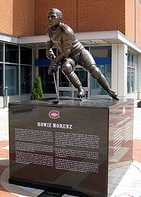
The Stratford Streak played eleven consecutive seasons for Les Habitants (1923 – 1934). In that time he became the brightest star ever to appear in the Canadiens’ constellation. With their flashing speed and laser-like scoring abilities, he and his teammates filled not only the Mount Royal Arena but also every NHL arena they visited. Teamed with his friend and line mate, Aurel Joliat, he was never far from leading the league in goals scored and points earned. Though not a big man by NHL standards, (he stood 5’9” and weighed 165 lbs.) he played with a ferocity and passion that made him seem much bigger to his opponents.
In the 1927-1928 campaign, Howie Morenz set a new league record, breaking the fifty-point barrier for the first time in the league’s history with 33 goals and a 51-point total. His 18 assists also tied the league record set the year before by Chicago Blackhawk Dick Irvin.
In 1929-30, he scored 40 goals in 44 games, and led his team to another Stanley Cup, adding three playoff goals to his totals, one of which was the Cup winning goal against the Boston Bruins. The following season he won the Hart Trophy for the second time, his second Art Ross Trophy for the scoring title and his third Stanley Cup.
Trouble Brewing in Montreal
In 1931-32 dark financial clouds were gathering over the Montreal Canadiens and their hard-working blue-collar fans. Every team in the league was affected by the stringent conditions brought on by the Great Depression. Thousands of seats in their home rink were empty, game after game. Despite winning his third Hart Trophy that year, Howie worried about his and his team’s future.
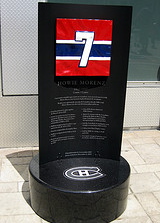
Cecil Hart resigned the coaching position. Soon after, Dandurand and Cattarinich decided to sell the team to The Canadian Arena Company, owners of the Montreal Forum, for one hundred sixty-five thousand dollars. To make matters worse, in the fall of ’33 the years started to catch up to the great Stratford superstar. Canadiens were no longer dominating their opponents. As he struggled with his scoring touch, the fans turned against him, disappointed that their hero could no longer leave defenders bewildered at the blue line. His vaunted speed was now a step slower. On October 1, 1934, the rumors that had been bandied about in the Montreal press, rumors that the team was preparing to trade him, suddenly came to fruition. Headlines blared that the great Howie Morenz was traded to Chicago.
Morenz’s Unhappy Trade
Without his beloved Bleu, Blanc et Rouge jersey Morenz was devastated. His turn in Chicago ended mercifully with a trade eighteen months later to the New York Rangers. His results there were not much better. At the end of that miserable season, Howie was forced to ask himself if indeed this was the end. Was it indeed time to hang them up? Then, to his delight, a miracle occurred.
The Canadiens had not fared much better than Morenz after their separation. The team was experiencing fiscal deficits, losing seasons, empty stands and disillusioned new owners. Looking to right the ship, the new management reached back in the club’s history to rehire Cecil Hart, the winningest coach in their history. Hart’s one condition for returning behind the bench was that the club re-acquire the Stratford Streak. Days later the deed was done and a jubilant Morenz could not believe his good fortune. He would return where he always knew he had belonged.
The End of a Storied Career
The season started out with the Canadiens battling the Montreal Maroons for first place. The rivalry was renewed, the spirit was back in the team, and the fans were returning. Morenz was high on his and the club’s future. Reunited with Aurel Joliat and his old teammates the magic had returned.
On January 28 the Canadiens played the Black Hawks at home. Early in the game Morenz darted into the Chicago end with burly defenseman Earl Seibert in close pursuit. Suddenly, he lost an edge and fell feet-first towards the end boards. The blade of his left skate sliced through a crack in the planks. Seibert, caught by surprise at the fall, was unable to stop and piled into the fallen winger. The momentum of the collision carried both players further toward the goal but the snared leg did not move. Spectators could hear the bone snap.
Writhing in pain, he was carried from the ice by his teammates and later taken to L’Hopital St-Luc, where the club doctor determined that his leg was broken in four places.
Morenz’s Injury
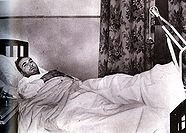
Hockey fans across North America prayed for his recovery. Bags full of get-well mail arrived at the hospital and at the Forum. After the initial expectation that the leg would heal quickly, reality and the seriousness of his injury slowly seeped into the atmosphere surrounding him. The fallen star became obsessed with the realization that he would never play again. His passion, “the fire in his belly”, that had driven him to the elite level of modern hockey was now turning inward on him, gnawing away at his psyche. He did not sleep and he would not eat. By the first week of March his doctor determined that he had suffered a nervous breakdown and ordered all visitation stopped so he could recover.
On March 8, suffering from chest pains late in the day, he was diagnosed with a heart attack. That night, around eleven-thirty, he struggled out of bed headed for the washroom. He never made it. Falling hard to the floor of his room, his heart gave way and he quickly passed away.
Saying Goodbye to Howie Morenz
The funeral was held on March 10 at the Montreal Forum. The doors opened at 11 a.m. and thousands of fans had formed a three-wide line all the way around the building, waiting to file past the casket and pay their last respects to their idol. His commitment to excellence in every aspect of the game, his loyalty to his team, and his love of the fans had won him a permanent place in their hearts. No one would ever replace him.
The service began at 2:30. Every seat in the building was filled. Thousands, after being turned away, milled about in the surrounding streets. His wife Mary and the children Howie Jr., Donald and the baby, Marlene sat in the first row of chairs placed on the boarded-over ice surface. Eight of his teammates acted as pallbearers and, at the conclusion of the eulogy, followed his cortege to the Cote-des-Neiges Cemetery where he was laid to rest.
Aurel Joliat spoke for the entire masses when he told the press: “Hockey was Howie’s life. When he realized he would never play again, he couldn’t live with it. I think Howie died of a broken heart.”
Enjoy more great hockey history and ‘Best of’ posts in the THW Archives
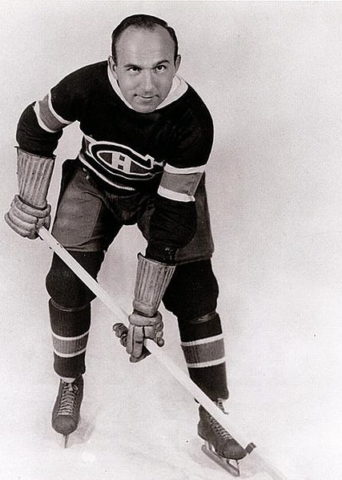
Brilliant encapsulation of the Howie Morenz story into one brief article. With the use of well-written narrative, pictures and videos, you’ve managed to tell everything important there is to know about the NHL’s greatest superstar of the 1920’s and early ’30’s. Bravo Kevin. Nicely done.
I’m glad you detailed how the Canadiens aggresively went into Toronto’s back yard in Stratford to sign Morenz, a non- French Canadian boy. It led to 3 more Stanley Cups for Montreal in the team’s unmatched history.
Fantastic read, Kevin – looking forward to the next piece in the series – you’ve set a high standard already & will be tough to be beat this one!